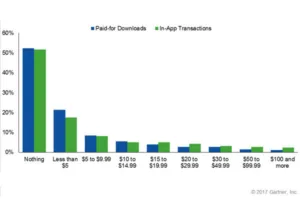Over half of smartphone users spend no money on smartphone apps (paid-for downloads and in-app transactions) *, according to a new survey by Gartner, Inc. However, end-user spending on in-app transactions continues to rise.
“Where users are prepared to pay for apps, spending on in-app transactions is on the rise — up 26% from 2015 — while spending on paid-for downloads only increased 4% in 2016,” said Stéphanie Baghdassarian, research director at Gartner. In this year’s survey, mean spending on in-app transactions was $11.59, while mean spending on paid-for downloads reached $7.67.
Paid-for downloads are more likely to be associated with smaller amounts of spending. Respondents who spent $15 or more over a three-month period were more likely to have done so through in-app transactions. “This is largely because the vast majority of paid-for mobile apps have a price tag of $1.99 or less, while the activation of in-app transactions usually means that the user has found value in an app and will be happy to spend more on it,” Ms, Baghdassarian added.
Age and gender also influence spending levels. Older millennials (people aged 25 to 34 years) are the biggest spenders on both paid-for downloads and in-app transactions, with their in-app transactions generating an average of $19 per quarter and their paid-for downloads an average of $13.40. The second-biggest spenders are the younger Generation X (people aged 35 to 44), who spend more on in-app transactions than paid-for downloads.
“As respondents grow older, they seem to be less keen to spend money within an app, and would rather pay for an app upfront,” said Ms, Baghdassarian. “The 18-to-24 age segment shows low average spending on paid-for downloads and high average spending on in-app transactions, at $3.80 against $12.10. This trend is likely to continue as these young millennials grow older.”
The survey also revealed noticeable differences in spending levels and usage between men and women for both paid-for downloads and in-app transactions. Women not only spend less money overall on mobile apps, but also use them less. They are, however, more likely to try a “freemium” approach (the other name for the in-app transaction business model) that lets them try an app before deciding whether to spend money on it.
“Consumers’ increased preference for in-app transactions is a clear sign that technology product marketing leaders working for app providers should invest in this model to provide flexibility in how they engage with app users,” said Ms, Baghdassarian.
Flexibility of business model is not the only requirement for a strong user experience, however. Brands should also investigate new ways of delivering content to users, as mobile apps may not always represent the best user interface. “Bots and virtual assistants could prove better, depending on the user, the context and other requirements,” said Ms, Baghdassarian. “At any rate, new and improved touchpoints are crucial for the success of any brand.”

